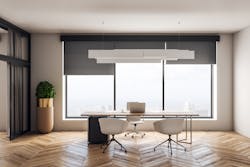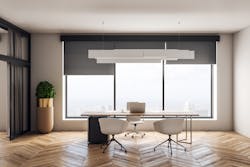As architects, engineers, and designers start planning the post-Covid-19 workplace, one element stands out: Now is the time to think long and hard about improving how we design and use office space.
The office of the future likely will be much more fluid. If businesses expect to attract and retain a productive workforce, they must rethink the office space and focus on flexibility that caters to all types of workers (Photo 1).
These new spaces must consider social interaction, collaboration, and relationship building — with a greater emphasis on technology.
Elements such as better room ventilation with upgraded air filtration, greater exposure to daylight, access to outdoor workspaces, the introduction of plants and greenery, and acoustic materials are all part of the march toward prioritizing occupants' health and safety (Photo 2).
The sprint toward innovation and advancements in technology will invade every aspect of the building for communication, wellness, and operation. Companies will take a fresh look at where and how much space is required for collaboration and productivity. Common area spaces on the floor will be able to serve a variety of functions. For example, conference room tables, bar-height tables and chairs, cabinets, partitions, and other office furniture components with casters allow an area to serve as a classroom, lecture hall, or videoconferencing event — all on the same day.
Flexibility for the future
Looking ahead, electrical system design and installation methods are poised to support a greater variety of lighting systems and low-voltage data/information systems that offer more features, such as AV services, security, digital signage, and way-finding systems. Lighting systems with integrated sensors will provide emerging capabilities like asset tracking, optimized space usage, building integration along with HVAC optimization, CO2 monitoring, and safety features.
Safety systems can provide data and visualization of the density and movement of people, monitor workplace cleaning and disinfection, create real-time overcapacity alerts for spaces, perform digital contact tracing, and more.
With LEDs becoming the dominant source of illumination, versatile lighting control systems that allow reconfiguration of space via software eliminate the need for rewiring when a workspace has to support a new function. Today’s control systems allow staff (or the occupant) to implement features such as warm dimming, tunable white, full-spectrum control, and circadian-effective light. Additionally, a variety of standards and guidelines are available to support circadian lighting systems — from the Lighting Research Center’s circadian stimulus metric to UL’s new Circadian Design Guide 24480 to the WELL standard and more.
Circadian lighting describes the ability of a lighting system to support the alignment of a human’s circadian rhythms with their daytime activity and nighttime sleeping pattern. When daylight is unavailable, controls can modulate the intensity, spectrum, and color temperature of lighting systems in keeping with the natural lighting cycle. The natural lighting cycle helps people regulate the creation of melatonin to maintain a 24-hr cycle of activity and sleep. It also offers the potential to increase alertness during working hours. These types of lighting systems emit cool, white light with predominantly blue wavelengths in the morning with the light shifting to warmer colors (red and orange) in the afternoon and evening when the body releases melatonin, the hormone that makes people sleepy. For circadian response, the key factors are the quantity of light falling on the eye’s photoreceptors during the day, the spectrum or wavelength of light, and the amount of time of light exposure.
The growing demand for flexibility and adaptability of an office lighting system is assisted by a recently refined concept called luminaire level lighting controls (LLLCs), which use LED luminaires with integrated sensors and controls. These have the potential for wide adoption because they can deliver impressive energy savings and operational flexibility in any type of post-Covid office layout.
Each luminaire is independent of all other luminaires, achieving incremental control within a small area — typically 80 sq ft to 120 square ft. The luminaire is equipped with an occupancy sensor and ambient light sensor, a luminaire controller, and a continuous dimming ballast/driver. It also features a gateway to transfer information, software to provide simple commissioning, and monitoring and data collection software for occupancy and lighting energy consumption.
A key feature of the technology, however, is that the fixture-level sensors and connectivity allow for integration with other building systems, such as automated interior shades, to achieve even greater energy cost savings. More than two dozen major lighting manufacturers presently offer LLLC systems, and most sales have been for retrofits.
Solving a problem
When people start returning to the office, worktables in these spaces should be easily relocatable. Thus, electrical power outlets at conference tables should be convenient and safe. A code-compliant, reconfigurable, modular power system for up to six receptacles, each with an adjacent USB-A and -C charging station, is now available.
The modular power system, connecting up to six power receptacles or units, starts with the primary unit that is connected to a permanent wall or floor outlet via a non-detachable power supply cord (125V,15A). The primary unit is rated 125V,15A; all other subordinate units, rated 125V, 12A, are connected to the primary unit via interconnected cords that use grounding type, non-NEMA style connectors. The interconnected cords are available with a circuit breaker for additional safety and code compliance. In addition, the faceplate also includes USB-A and -C charging slots.
This modular power system satisfies the new UL Supplement SD — "Furniture Power Distribution Units for Portable (Movable) Work Space Table," which is included under UL 962A — the ANSI/UL Standard for Furniture Power Distribution Units. Additionally, NFPA1 Section 11.1.4.2 states that “the relocatable power taps shall be directly connected to a permanently installed receptacle.” In addition, UL 1363, the Standard for Relocatable Power Taps, states that an RPT is not intended to be series connected (daisy-chained) to other RPTs or extension cords.
Working outdoors
An increase in the use of outdoor workspaces brings with it the need for code-compliant power and data connectivity equipment at patios, terraces, lawn areas, and rooftops for mobile equipment, such as outdoor projectors. For example, a recently developed outdoor ground box provides convenient power, communications, and A/V to serve these types of outdoor locations.
Sustainable and human-friendly buildings
The demand for buildings that support and enhance health has been mounting since the 1970s but has lately seen exponential growth. The recent pandemic underscores the importance of air purification systems in buildings going forward (see The New Wave of Sustainability at the end of the article).
C-PACE-eligible enhancements to improve the air quality of buildings by reducing viruses and bacteria include High-Efficiency Particulate Air (HEPA) filtration, bipolar ionization, and UV light purification. HEPA filtration efficiently catches particles the size of or smaller than the virus that causes COVID-19. Existing HVAC systems can be upgraded to incorporate HEPA filters. Bipolar ionization (a technology that can be integrated into HVAC systems) is a process where atoms and molecules absorb or eliminate an atomic bond to neutralize another microorganism, such as COVID-19 and other viruses, bacteria, mold, mildew, or allergens. Finally, ultraviolet (UV) light disinfects by altering the genetic material in pathogens, including the RNA in viruses. The use of UV light purification to disinfect is a long-standing technology that can be installed directly on heating and cooling coils in forced-air systems. In-room UV air purification systems are also taking the market by storm.
Healthy building strategies are no longer seen as “nice to have.” They are now must-haves for building owners who want to provide tenants, employees, and consumers the confidence to re-enter buildings safely. Demand for healthy buildings is expected to rise significantly in the wake of the pandemic. According to Assistant Professor of Exposure and Assessment Science and Director of the Healthy Buildings program at the Harvard T.H. Chan School of Public Health Dr. Joseph G. Allen, the time is now.
“This is an all-in moment for us,” Allen says. “The healthy building movement was already gaining steam, but instead of it taking another five or six years, it’s taken off in the past two months due to COVID-19.”
SIDEBAR: The New Wave of Sustainability
Leadership in Energy and Environmental Design (LEED) and other green building standards historically focused on the energy efficiency of buildings. The newest wave of sustainability is focused on the health, productivity, and well-being of those who work inside the buildings.
The WELL Building Standard emerged in 2014 as a third-party rating system similar to LEED certification but instead evaluates the impact of building design on the health and well-being of occupants. The WELL rating is based on 10 categories, each with various specifications. One of the categories is light, which includes 13 specifications for light output and levels, lighting controls, reflectances, visual comfort, and daylighting.
Concerning the color quality feature, a CRI of 80-plus must be specified for all light sources except decorative, emergency, and special-purpose.
For the automated dimming and controls feature, there are two main requirements. All windows larger than 6 sq ft must have automatic shades that respond to light sensors indicating sunlight could create glare. All lighting (except decorative) must be controlled by continuous dimming controls that respond to daylight levels and occupancy sensors that automatically dim to 20% or off when the zone is unoccupied. Circadian lighting, glare reduction, visual acuity, daylighting, surface reflectances, and night lighting are also covered.


